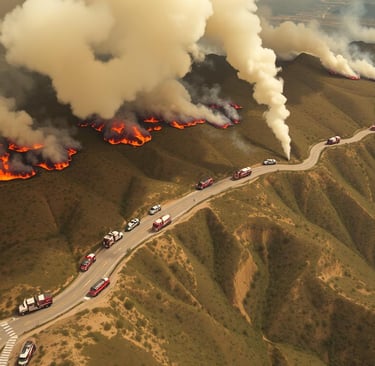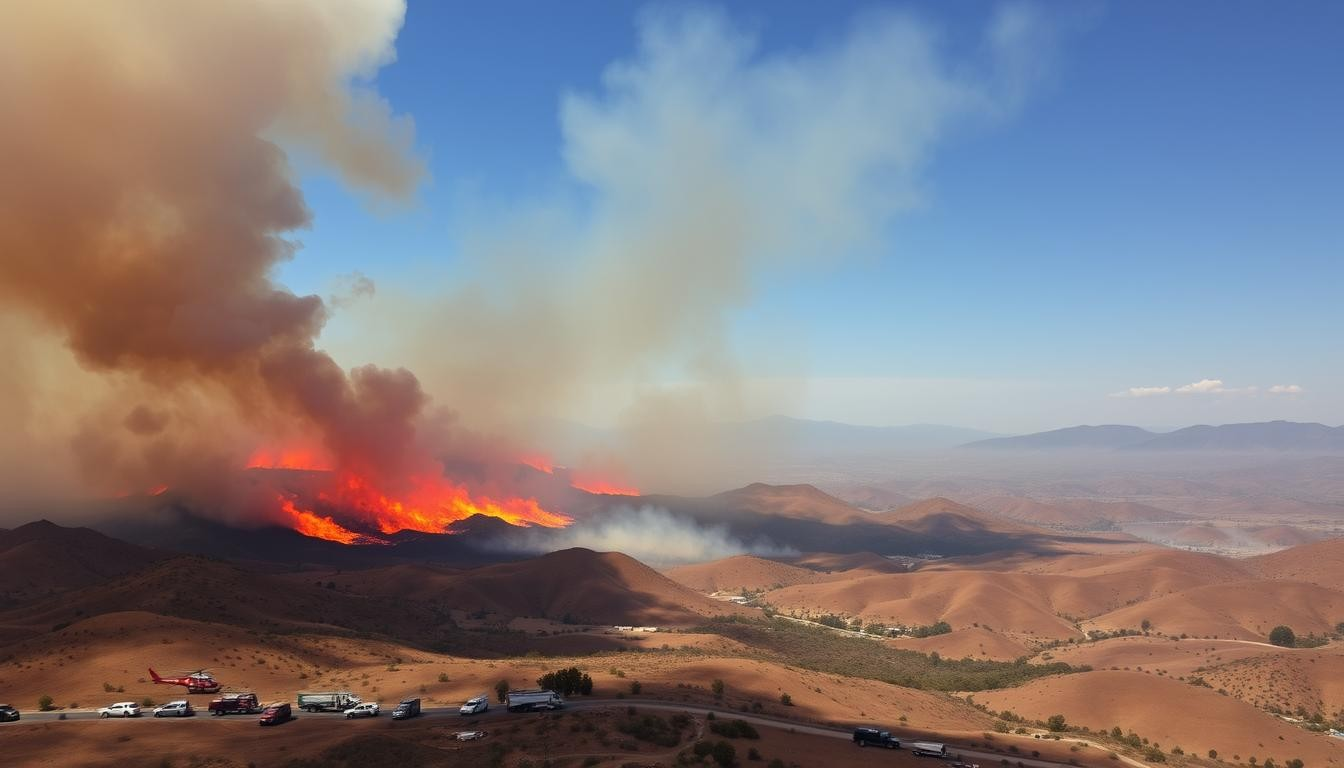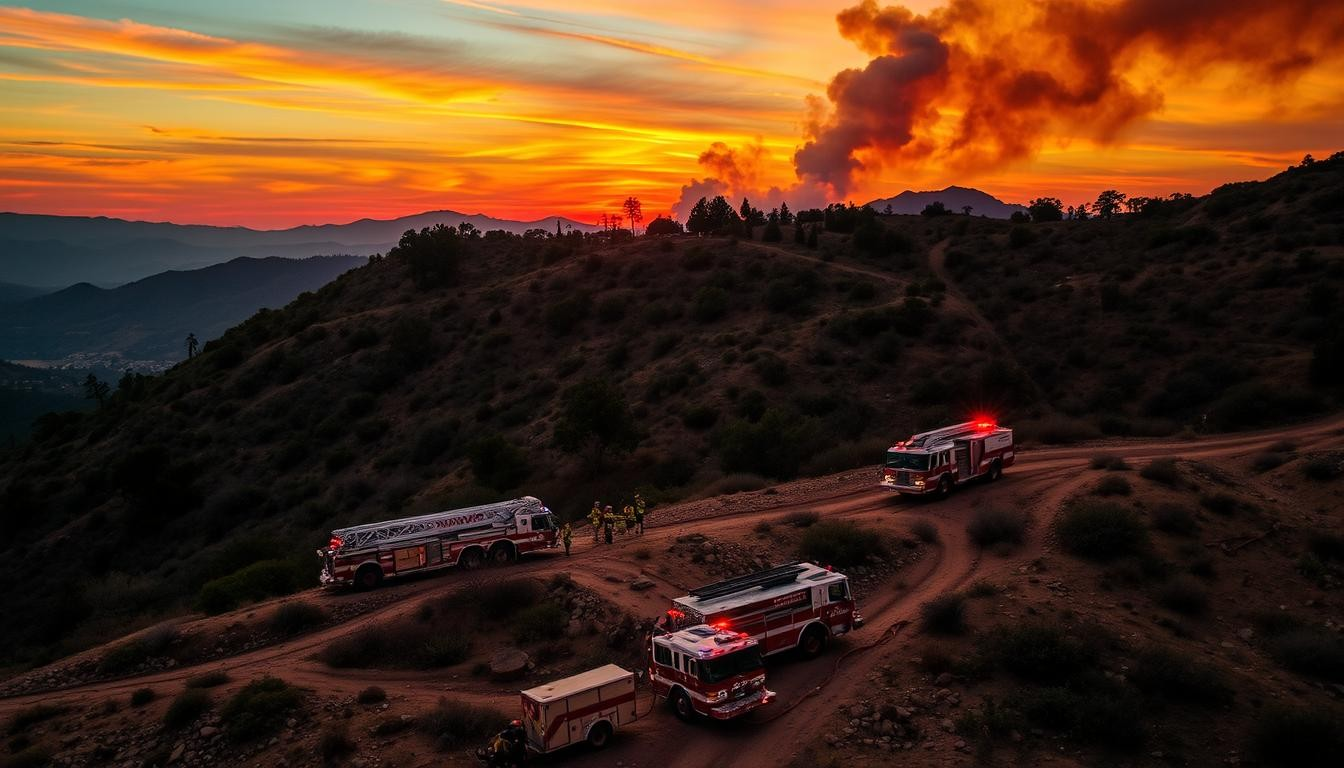Behind the Flames: The Complex Logistics of Fire Departments in Los Angeles Wildfires
Dive into the logistics behind Los Angeles fire departments' response to devastating wildfires, and learn why their efforts are essential for community safety.
1/16/202510 min read


The recent Los Angeles wildfires have caused huge damage, burning thousands of acres and destroying homes. The death toll from these fires is now 16 people, with over 12,000 homes burned. It's important to understand how fire departments work to fight these fires. This includes their equipment, people, and technology.
The Los Angeles Fire Department faces challenges like strong Santa Ana winds and low humidity. These factors help fires spread fast. Over 2,300 firefighters are working hard to stop the fires. The economic damage from these fires could be between $60 billion and $130 billion.
Knowing how fire departments handle wildfires in Los Angeles is key. It helps us find better ways to fight these fires.
Key Takeaways
The recent Los Angeles wildfires have highlighted the importance of understanding the complex logistics of fire departments in responding to these devastating fires.
Strong Santa Ana winds and low humidity levels have hindered the Los Angeles Fire Department's response to the wildfires.
The economic losses from the fires are estimated to be between $60 billion and $130 billion.
Understanding the logistics behind fire departments is crucial to combating wildfires in Los Angeles.
The Los Angeles Fire Department's budget for fiscal year 2024-25 was cut by $17.6 million, which is approximately 2% of the total $820 million budget.
Over 2,300 firefighters are actively engaged in battling the blazes across Los Angeles.
The Rising Threat of California Wildfires in Los Angeles
California wildfires have become a big worry for Los Angeles. The city has seen some of its worst fires ever. The supply chain of water and equipment is under a lot of pressure as firefighters try to stop the fires.
Strong winds, dry conditions, and logistics resources have made the fires spread fast. This has caused a lot of damage to the community.
In California, wildfires are more common because of the dry climate and strong winds. The supply chain of resources, like water and equipment, is key in fighting these fires. Good logistics resources help firefighters have what they need to fight the fires.
The recent fires in Los Angeles show how important it is to know what makes fires spread. This includes environmental factors and challenges at the urban-wildland interface.


Some important statistics about the recent wildfires in Los Angeles are:
Over 37,700 acres have been burned in the Palisades and Eaton fires
At least 25 people have died due to the wildfires
More than 100,000 individuals have been displaced as a result of the wildfires
Over 172,000 people in Los Angeles County are under current evacuation orders or warnings
The California wildfires have destroyed thousands of homes. They have had a big impact on the community. The supply chain of resources, including water and equipment, is under a lot of pressure as firefighters try to stop the fires.
Effective logistics resources are crucial. They ensure firefighters have the tools and equipment they need to fight the fires.
Understanding Fire Department Response Systems
The Los Angeles Fire Department (LAFD) has many ways to fight wildfires. They use firefighters, special equipment, and technology. They have ground and air teams ready to go, like fire engines, helicopters, and planes. Logistics are key because getting resources quickly is crucial to stop fires.
In Los Angeles, the fire department tackles wildfires in special ways. They use modern tools like GPS and satellite images to help fight fires faster. They also team up with other groups to fight fires together, making their efforts stronger.


Firefighter training and deployment
Equipment maintenance and deployment
Technology integration and support
Coordination with other agencies and organizations
These parts work together to help the LAFD fight wildfires fast. This helps keep people and buildings safe in Los Angeles.
Knowing how the fire department responds to wildfires helps us understand the big challenge they face. The LAFD uses logistics, technology, and teamwork to protect the community. This way, they reduce fire damage and keep everyone safe.
Critical Resource Management During Wildfire Events
Effective logistics are key in managing resources during wildfires. The Los Angeles Fire Department (LAFD) uses smart strategies to get the right resources to the right place. This includes how they deploy equipment, distribute personnel, and manage the supply chain.
A well-run supply chain is vital for firefighters to have what they need. This includes food, water, and medical supplies. The LAFD works with suppliers to keep the supply chain flowing smoothly. During a wildfire, managing resources well can mean the difference between stopping the fire or letting it spread.
Some important strategies for managing resources during wildfire events include:
Equipment deployment strategies: getting the right equipment to the right place, like fire engines and helicopters.
Personnel distribution methods: sending firefighters to the right spot, like the fire's front lines.
Supply chain coordination: managing the supply chain to make sure resources are ready for firefighting efforts.
By using these strategies, the LAFD can manage resources well during wildfire events. This ensures the right resources are in the right place at the right time. It helps to keep the fire contained, protect people and property, and lessen the wildfire's impact on the community.
Technology's Role in Modern Wildfire Combat
Technology is key in fighting wildfire today. Tools like drones and satellite images give firefighters real-time data. This data helps them know where the fire is, how big it is, and how fast it's spreading.
Thanks to technology, fighting wildfires has gotten better. Sensors can spot changes in gases and particles quickly. Satellite maps powered by Lidar give updates all day long. This lets firefighters make smart choices.
Artificial intelligence-powered cameras for smoke detection
Datacasting technology for rapid data delivery
Autonomous robots for extreme environment operations
Aerial drones for aerial reconnaissance
These tools make fighting wildfire more efficient. They help get resources to the right place faster. This is a big help in the battle against wildfire.
TechnologyDescriptionFire Integrated Real-Time Intelligence System (FIRIS)Provides real-time mapping of active wildfiresLidar TechnologyCreates detailed 3D maps of high-risk areasAI-powered CamerasPerform 360-degree sweeps for smoke detection
The Human Element: Firefighter Deployment and Safety
Firefighter deployment and safety are key in managing wildfires. The Los Angeles Fire Department (LAFD) uses systems to keep firefighters safe. These include shift management, rest and recovery plans, and mental health support.
Good logistics are vital for firefighter safety. The LAFD's systems help manage firefighter deployment. They provide the needed resources and support for safe work.
Shift Management Systems
Shift management systems help manage firefighter deployment. They ensure firefighters get enough rest and can work safely. This includes rotating shifts and giving them time to rest.
Rest and Recovery Protocols
Rest and recovery protocols give firefighters time to rest between shifts. They have access to food, water, and medical care. They also have a safe place to rest.
Mental Health Support
Mental health support is crucial for firefighters. They often face traumatic events. The LAFD offers counseling and peer support to help them deal with job stress.
In conclusion, the human element is vital in wildfire management. The LAFD's systems ensure firefighters are safe and can work well. This includes shift management, rest and recovery, and mental health support.
SystemDescriptionShift ManagementManages firefighter deployment to ensure safetyRest and RecoveryProvides access to food, water, and medical careMental Health SupportOffers counseling and peer support
Communication Networks and Command Structures
Effective communication and logistics are key in firefighting. They help coordinate resources and share info between firefighters, emergency responders, and the public. The Los Angeles Fire Department (LAFD) uses radio, telephone, and internet systems for this.
Good command structures are vital. They help deploy resources well, keeping firefighters and responders updated. This is crucial in wildfires, where logistics and communication are key to controlling the fire and keeping people and property safe.
Some effective communication and command strategies include:
Using emergency operations centers (EOCs) to share info and coordinate actions
Implementing advanced fire detection technologies, like satellite monitoring and AI analysis
Expanding emergency alert systems to reach people through various channels
By using these strategies, the LAFD can improve its communication and command systems. This will help it respond better to wildfires and keep the community safe.
StrategyDescriptionEmergency Operations Centers (EOCs)Disseminate information and coordinate actions during crisesAdvanced Fire Detection TechnologiesUtilize satellite monitoring and AI-powered analysis to detect firesEmergency Alert SystemsReach residents via multiple channels to provide critical information
Community Impact and Evacuation Logistics
Wildfires can have a big impact on communities, forcing thousands to leave their homes. Getting people to safety is key. This includes planning evacuation routes, setting up emergency shelters, and keeping everyone informed.
Planning evacuation routes is critical. It means finding the safest ways for people to leave. Emergency shelters provide a safe place to stay, with food, water, and medical care. Keeping the public updated is also important, with information on evacuation orders and shelter locations.
The community is essential in helping with evacuations. Local groups and residents can assist with planning routes, setting up shelters, and spreading the word. Together, we can reduce the effects of wildfires and ensure a safe evacuation.
Evacuation EffortsCommunity SupportEvacuation Route PlanningLocal organizations and residents provide assistanceEmergency Shelter CoordinationAccess to food, water, and medical carePublic Communication StrategiesKeeping the public informed about the latest information
Understanding the role of logistics, community, and evacuation is crucial. By working together, we can make our response to wildfires safer and more effective.
Inter-Agency Cooperation in Wildfire Response
Responding to wildfires needs inter-agency cooperation. This ensures effective use of resources and sharing of information. The Defense Department (DOD) is working with agencies like Agriculture and Homeland Security. They aim to improve wildfire recovery efforts.
A new agreement has been made to help with interagency coordination after wildfires. Agencies will share resources like people, equipment, and technology. They will also work together on firefighting, evacuations, and sheltering. This teamwork is key to dealing with wildfires' effects, which can be more expensive than the fires themselves.
Some important steps include:
The DOD has spent over $500,000 on projects at the Pohakuloa Training Area in Hawaii.
The DOD Legacy Resource Management Program gave $663,877 to 12 projects and research.
The White House Wildland Fire Resilience Interagency Working Group made the agreement. It followed the Wildland Fire Mitigation and Management Commission's advice.
By teaming up, agencies can better manage logistics and respond faster. This helps lessen wildfires' impact on communities and nature. This cooperation is vital for wildfire response. It allows for the coordination of resources and the sharing of information between agencies.
Financial Aspects of Wildfire Management
Managing the finances of wildfire management is key. It helps fund firefighting efforts. The Los Angeles Fire Department (LAFD) uses various financial systems. These include budgeting, planning for resources, and managing emergency funds.
Important financial logistics in wildfire management include:
Budget allocation: Funds are set aside for firefighting, like buying equipment and deploying teams.
Resource investment planning: The fire department plans for future needs, like new gear and tech.
Emergency fund management: Funds are managed for emergency responses, including deploying resources and coordinating efforts.
Affected residents might get help with property taxes, casualty loss deductions, and more. It's crucial to keep receipts for disaster expenses. This helps with insurance and tax claims. The LAFD works to fund wildfire management and support affected residents.
Financial AspectDescriptionBudget AllocationAllocating funds to support firefighting effortsResource Investment PlanningPlanning for the long-term needs of the fire departmentEmergency Fund ManagementManaging funds to support emergency response efforts
Conclusion: Strengthening Los Angeles Fire Defense Systems
The complex logistics of fire departments in Los Angeles are key to fighting devastating wildfires. The Los Angeles Fire Department (LAFD) has a strong setup of equipment, people, and tech. Yet, it faces many challenges, like limited resources and the growing threat of wildfires.
To make Los Angeles' wildfire defense stronger, we need to keep supporting the LAFD. This means giving them the funds they need for firefighting, updating their gear, and finding new tech. Also, teaching the public about fire safety is vital. It helps people know how to protect their homes from fires.
By improving the LAFD's , getting ready for , and working with the community, Los Angeles can fight fires better. With everyone working together and a strong focus on fire safety, the city can keep its people, buildings, and nature safe for years to come.
FAQ
What are the recent major wildfire events that have highlighted the importance of understanding fire department logistics in Los Angeles?
The Woolsey Fire and the Getty Fire have shown us how crucial it is to know how fire departments work. They help us understand the complex ways they respond to these big fires.
What environmental factors contribute to the spread of wildfires in Los Angeles?
Strong winds and dry conditions help wildfires spread in Los Angeles. Also, homes near wild areas make fires more likely.
What are the key components of fire department response systems in Los Angeles?
The LAFD has many systems to fight fires. Firefighters use different techniques. They also have equipment like fire engines and technology like GPS.
How do fire departments manage critical resources during wildfire events?
Managing resources well is key during wildfires. The LAFD uses strategies like deploying equipment and coordinating supplies.
What is the role of technology in modern wildfire combat?
Technology is very important in fighting wildfires today. It gives real-time fire info and helps with communication and coordination.
How do fire departments ensure the safety and well-being of firefighters during wildfire events?
The LAFD has systems for firefighter safety. This includes managing shifts, rest, and mental health support.
What are the key components of communication networks and command structures during wildfire response?
Good communication is vital. The LAFD uses radio, phones, and internet to coordinate efforts and inform everyone.
How do fire departments and other agencies work together to support evacuation efforts during wildfires?
The LAFD teams up with others for evacuations. They plan routes, set up shelters, and communicate with the public.
What is the importance of inter-agency cooperation in responding to wildfires?
Working together is crucial. It helps share resources and info between agencies, making responses better.
How do fire departments manage the financial aspects of wildfire management?
The LAFD has financial systems for wildfires. This includes budgeting, planning, and managing emergency funds. It ensures they have the money to fight fires effectively.
Source Links
Was the biggest LA wildfire ‘started by idiots’? Where the evidence points
Firefighting Efforts in the 2025 Los Angeles Wildfire | J&Y Law
How Could This Happen? Answering Frequently Asked Questions About the L.A. Wildfire Disaster
California Wildfires Live Updates: Fire-Stoking Winds Expected to Ease Soon
Firefighters report progress against wildfires as LA braces for dangerous winds
How to Implement a Fire Department Crisis Response Program - Julota
Risk Informed Wildfire Management | Northern Rockies Fire Science Network
California Wildfire Devastation: Analyzing Environmental Policies and Community Resilience
California’s wildfire crisis: Expert insights on causes, spread, and solutions
How Technology Helps Fight The Flames Of California Wildfires - SlashGear
Innovative Tech at the Forefront of California’s Wildfire Fight - Innovation & Tech Today
Urban Wildfire Risks in Sydney: How AI and Climate Change Are Reshaping Fire Safety Strategies
Wildfires, Wealth, and Inequality: The Controversial World of Private Firefighters
What Local Officials Should Do When Facing a Wildfire: Navigating Disaster Response and Recovery
DOD works with interagency partners on helping communities recover from wildfires
DOD Partners With Interagency on Helping Communities Recover From Wildfires
As Coordinated Wildfire Response Efforts Continue, FEMA Encourages Californians to Apply for Aid
What L.A. wildfire victims need to know about taxes and other financial matters
Experts and Advocates Release Key Principles for Improving Wildfire Funding and Budgeting
Farmonaut's Critical Role: Monitoring and Managing Wildfire Impact on Los Angeles Agriculture
